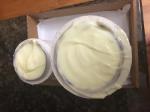Sour smell of goats milk
by Hilde Waterloo
(Leksvik, Norway)
Hi!
Another thing; I placed the soap bars down in the cellar as that is the only vacant place for them to cure - how cold can it be before it is too cold..?
Answer:
Hello Hilde,
Newly made soap can sometimes have a rather odd smell to it as the saponification process continues. Give the soap a week or so and see if the smell goes away.
If the smell doesn't go away then perhaps the milk was burnt by the lye? If the lye heats the milk too much it can go quite orange in colour and smell terrible. Some people freeze their milk into small icemilk cubes and add the lye to it like that. I haven't done it that way myself so I can't give you first had knowledge.
When I make milk soaps, I use just over half the amount of water and mix it with the lye. I then mix the oils with the lye solution until a very thin trace occurs. Then I add the milk (sometimes I add powdered milk to the liquid milk so that it is stronger) and continue to mix until a good trace is reached.
I'm not really sure what 'too cold' would be.....in the past I have put cold process soap into the freezer to help with releasing it from a fancy mold I was trying and found that the soap did not fare as well as soap that wasn't frozen. The surface developed a tacky feel to it that I didn't like and it had a sweaty film on it as it came back to room temperature.
I store mine at around 15 degrees Celsius (60 degrees Fahrenheit). I don't think I'd want to store it much below 10 degrees Celsuis (50 degrees Fahrenheit).
Happy soaping,
Cathy
Comments for Sour smell of goats milk
|
||
|
||
|
||
|
||
|
||
|
||
|
||
|
||
|
||
|
||

